The Arctic is burning and Greenland is melting, thanks to record heat
Blazes are pumping record amounts of CO2 into the air, which could make the problem worse
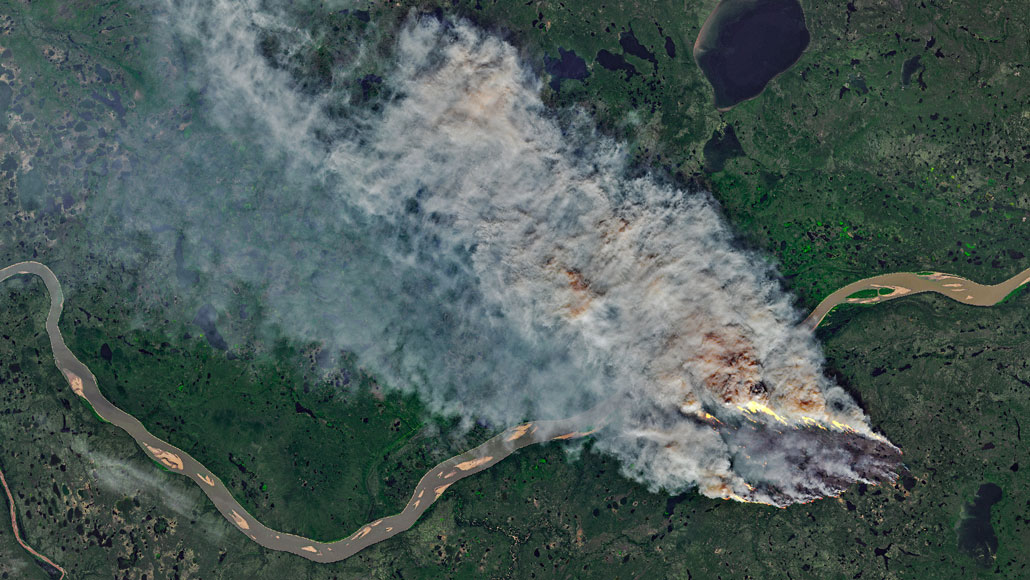
CANADA ABLAZE The European Space Agency’s Copernicus Sentinel-2 satellite snapped this image July 27 of wildfires near the Mackenzie River in Canada’s Northwest Territories.
Pierre Markuse/Flickr (CC BY 2.0)
- More than 2 years ago
The Arctic is on fire. Record-breaking temperatures and strong winds are fueling an unprecedented number of wildfires across the region this summer. In Siberia alone, hundreds of wildfires captured by satellite images July 28 spanned about 3 million hectares of land. Across Alaska, as many as 400 wildfires were burning as of mid-July. And the heat is also melting Greenland’s ice at an alarming rate.
The scale and intensity of the June 2019 wildfires are unparalleled in the 16 years that the European Union’s Copernicus Atmosphere Monitoring Service, or CAMS, has been tracking global wildfire data. And July’s numbers “have been of similar proportions,” says CAMS senior scientist Mark Parrington. “I’ve been surprised at the duration of the fires in the Arctic Circle, in particular.”
Wildfires most often occur in the Arctic in July and August, sparked by lightning strikes. But this year, unusually hot and dry conditions in the Northern Hemisphere in June exacerbated the problem and drove the fire season’s start earlier, the World Meteorological Organization reported July 12.
Unusually high temperatures and low precipitation in the region were almost certainly fueling the July wildfires as well, Parrington says. In early August, CAMS will release its monthly bulletin summarizing the July data, he adds, and “I wouldn’t be surprised if the July fires correspond to [those climate] anomalies.”
In Alaska, a heat record toppled July 4, with temperatures reaching as high as 32.2° Celsius (90° Fahrenheit). Average June temperatures in parts of Siberia were almost 10 degrees higher than the average temperatures from 1981 to 2010. That same month, more than 100 intense wildfires were burning within the Arctic Circle.
Melting Greenland
On August 1, the Copernicus Sentinel-3 satellite took this image of western Greenland. To the left of the island’s ice sheet, an active wildfire burns. Meanwhile, abundant melt ponds (appearing as blue spots) collect on the ice itself, another effect of record temperatures.
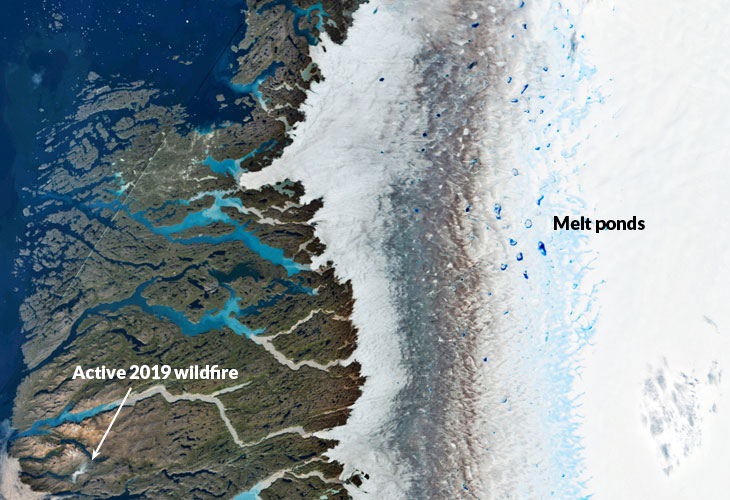
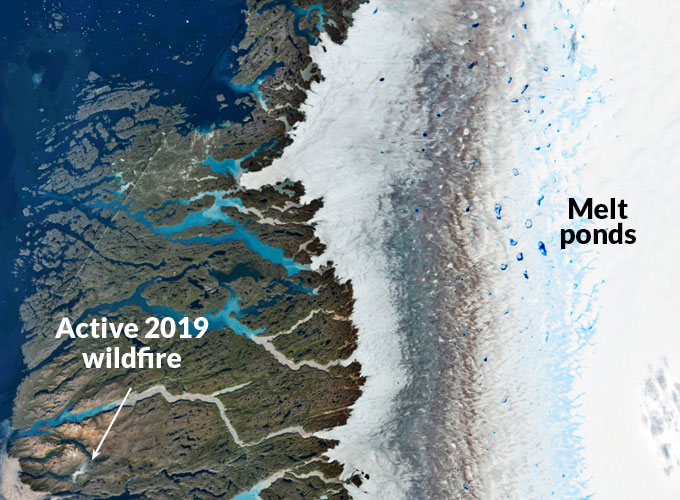
Greenland is also sweltering in the Northern Hemisphere’s heat wave: The island lost nearly 200 billion tons of ice in July, according to the Danish Meteorological Institute. On July 31, a record-breaking 56.5 percent of Greenland’s ice sheet was showing signs of melting, DMI glaciologist Ruth Mottram told the Associated Press. Images from the Copernicus satellite captured August 1 show multiple melt ponds, as well as burn scars from a recent fire and smoke from an active fire on the island.
The Arctic blazes are not only scorching vast swaths of Earth; they’re also releasing copious amounts of carbon dioxide. June’s fires alone released more than 50 metric megatons of carbon dioxide, the WMO said, more than the total released by all June fires from 2010 to 2018.
Total CO₂ emissions from the Arctic wildfires for July are estimated at about 79 megatons, Parrington says. That’s roughly double the emissions from the previous record-setting month: July 2004. That year also set a previous annual record, with total Arctic wildfire CO₂ emissions of about 110 megatons. 2019 has already smashed that record.
Carbon emissions
About 79 metric megatons of carbon dioxide were emitted by wildfires in the Arctic Circle in July 2019, smashing the previous record set in July 2004.
Carbon dioxide emissions from wildfires in the Arctic in July, 2003–2019
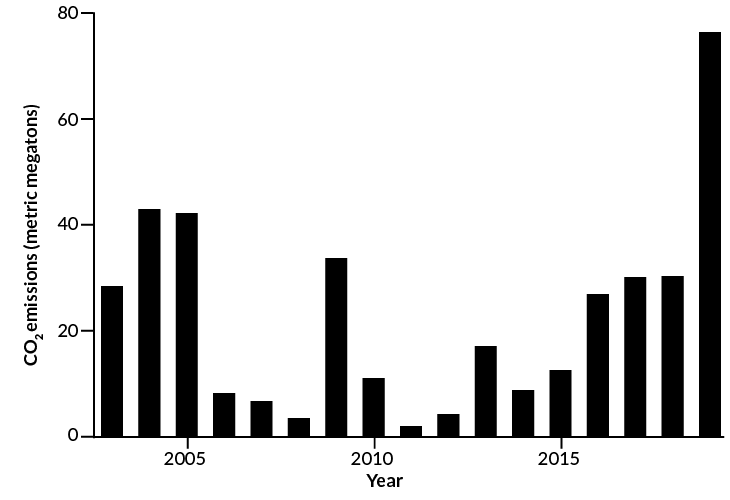
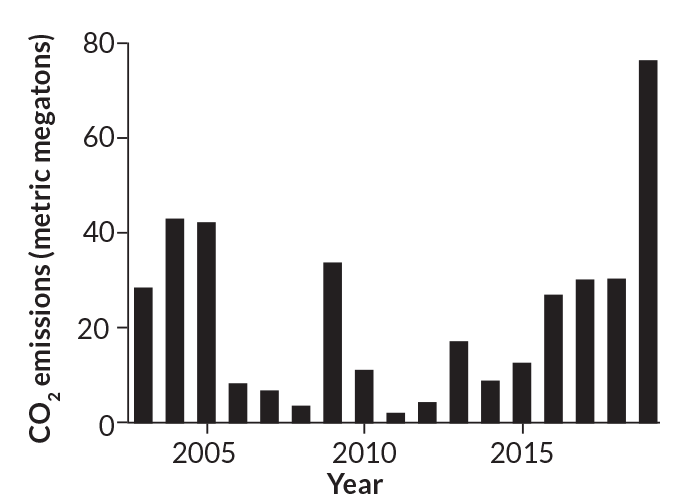
Emissions of CO₂ and other greenhouse gases are responsible for the current era of global warming (SN: 8/3/19, p. 7). Human-caused emissions of greenhouse gases have already warmed the planet by 1 degree C above preindustrial times. Temperatures in the Arctic are increasing twice as fast as the global average, further promoting the growth and persistence of wildfires in the region.
Such Arctic wildfires are expected to become more common as the planet warms. There’s geologic precedent for that: Layers of black charcoal in sediments in the Canadian Arctic suggest that wildfires frequently raged across the region during the Pliocene Epoch, when global atmospheric CO₂ levels were between 350 and 450 parts per million — similar to today (SN: 12/9/17, p. 24). In June, CO₂ levels averaged 413.92 ppm, according to data collected at the Mauna Loa Observatory in Hawaii.
Meanwhile, increasingly frequent winter warm spells, insect outbreaks and wildfires have also caused many Arctic plants to lose their resistance to freezing, dry out and die, turning large parts of the Arctic brown (SN: 4/13/19, p. 16). That, in turn, increases the region’s susceptibility to more wildfires: Normally, the icy peatlands are soggy enough to be fire-resistant, but they are thawing and drying out. Once set ablaze, the carbon-rich peat can burn for months, releasing large amounts of CO₂ back into the atmosphere and fueling the warming feedback loop (SN: 3/17/18, p. 20).






